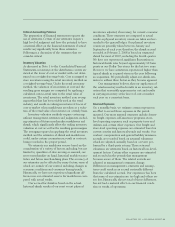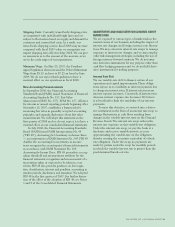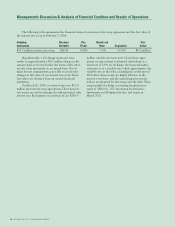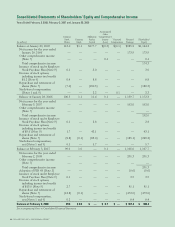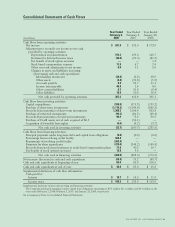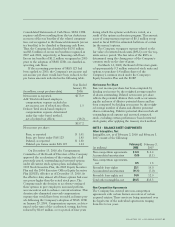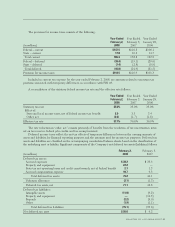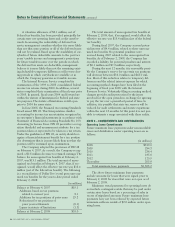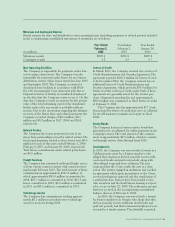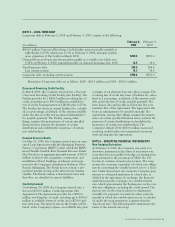Dollar Tree 2007 Annual Report Download - page 34
Download and view the complete annual report
Please find page 34 of the 2007 Dollar Tree annual report below. You can navigate through the pages in the report by either clicking on the pages listed below, or by using the keyword search tool below to find specific information within the annual report.
32
DOLLAR TREE, INC. • 2007 ANNUAL REPORT
Notes to Consolidated Financial Statements
Fiscal Year
The Company’s fiscal year ends on the Saturday clos-
est to January 31. Any reference herein to “2007” or
“Fiscal 2007,” “2006” or “Fiscal 2006,” and “2005” or
“Fiscal 2005,” relates to as of or for the years ended
February 2, 2008, February 3, 2007, and January 28,
2006, respectively. Fiscal year 2006 consisted of 53
weeks, while 2007 and 2005 both consisted of 52 weeks.
Use of Estimates
The preparation of financial statements in conformity
with U.S. generally accepted accounting principles
requires management to make estimates and assump-
tions that affect the reported amounts of assets and
liabilities and disclosures of contingent assets and lia-
bilities at the date of the consolidated financial state-
ments and the reported amounts of revenues and
expenses during the reporting period. Actual results
could differ from those estimates.
Reclassifications
Certain 2006 and 2005 amounts have been reclassified
for comparability with the current period presenta-
tion. The balance sheet at February 3, 2007 presented
herein reflects an immaterial correction which
increased other current assets and accounts payable by
$8.9 million. The gross amount of purchases of
restricted investments and proceeds from the maturi-
ties of restricted investments have been included in
2006 and 2005. These amounts were previously
reported on a net basis.
Cash and Cash Equivalents
Cash and cash equivalents at February 2, 2008 and
February 3, 2007 includes $12.8 million and $40.3
million, respectively, of investments in money market
securities and bank participation agreements which are
valued at cost, which approximates fair value. The
underlying assets of these short-term participation agree-
ments are primarily commercial notes. For purposes of
the consolidated statements of cash flows, the Company
considers all highly liquid debt instruments with original
maturities of three months or less to be cash equiva-
lents. The majority of payments due from financial
institutions for the settlement of debit card and credit
card transactions process within three business days, and
therefore are classified as cash and cash equivalents.
Short-Term Investments
The Company’s short-term investments at February 2,
2008, consist primarily of government-sponsored
municipal bonds. These investments are classified as
available for sale and are recorded at fair value which
approximates cost. The government-sponsored
NOTE 1 – SUMMARY OF SIGNIFICANT
ACCOUNTING POLICIES
Description of Business
On March 2, 2008, the Company reorganized by cre-
ating a new holding company structure. The primary
purpose of the reorganization was to create a more
efficient corporate structure. The business operations
of the Company and its subsidiaries will not change as
a result of this reorganization. As a part of the holding
company reorganization, a new parent company,
Dollar Tree, Inc., was formed. Outstanding shares of
the capital stock of Dollar Tree Stores, Inc., were auto-
matically converted, on a share for share basis, into
identical shares of common stock of the new holding
company. The articles of incorporation, the bylaws, the
executive officers and the board of directors of the
new holding company are the same as those of the
former Dollar Tree Stores, Inc. in effect immediately
prior to the reorganization. The common stock of the
new holding company will continue to be listed on the
NASDAQ Global Select Market under the symbol
“DLTR”. The rights, privileges and interests of the
Company’s stockholders will remain the same with
respect to the new holding company.
At February 2, 2008, Dollar Tree, Inc. (the
Company), formerly Dollar Tree Stores, Inc., owned
and operated 3,411 discount variety retail stores.
Approximately 3,300 of these stores sell substantially
all items for $1.00 or less. The remaining stores were
acquired as part of the Deal$ acquisition and these
stores sell most items for $1.00 or less but also sell
items at prices greater than $1.00. The Company’s
stores operate under the names of Dollar Tree, Deal$
and Dollar Bills. The Company’s stores average
approximately 8,300 selling square feet.
The Company’s headquarters and one of its distri-
bution centers are located in Chesapeake, Virginia.
The Company also operates distribution centers in
Mississippi, Illinois, California, Pennsylvania, Georgia,
Oklahoma, Utah and Washington. The Company’s
stores are located in all 48 contiguous states. The
Company’s merchandise includes food, health and
beauty care, party goods, candy, toys, stationery, sea-
sonal goods, gifts and other consumer items.
Approximately 40% to 45% of the Company’s mer-
chandise is imported, primarily from China.
Principles of Consolidation
The consolidated financial statements include the
financial statements of Dollar Tree, Inc., and its wholly
owned subsidiaries. All significant intercompany
balances and transactions have been eliminated in
consolidation.



